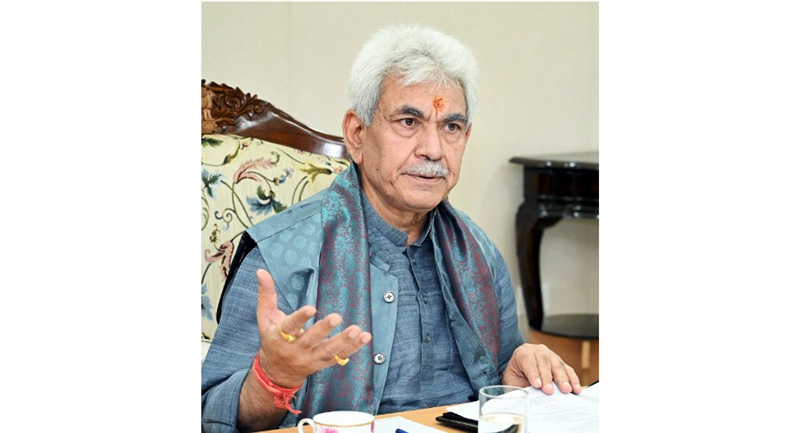SWD Directorates to be renamed
Excelsior Correspondent
SRINAGAR, July 8: The Administrative Council (AC) which met here under the chairmanship of the Lieutenant Governor, Manoj Sinha, accorded administrative approval to the Jhelum flood protection works by Jal Shakti Department in Kashmir division.
Rajeev Rai Bhatnagar, Advisor to the Lieutenant Governor, Dr. Arun Kumar Mehta, Chief Secretary, J&K and Nitishwar Kumar, Principal Secretary to the Lieutenant Governor attended the meeting.
The Administrative Council approved the Project-Comprehensive Plan for River Jhelum and its tributaries, Phase (II) Part (A), amounting to Rs 1623.43 crore under the PM’s Development Package.
The proposed works are based on the existing site conditions and issues of the main Jhelum downstream of Sangam up to Wullar Lake, flood spill channel and outfall channel including tributaries in order to safely mitigate a flood threat of 1700 Cumec (60000 cusecs). Channel improvement and protection works at vulnerable spots in river Jhelum, flood spill channel and outfall channel have been proposed to tackle the drainage congestion issues for safe passage of flood waters and to minimize the loss to life and property.
The project comprises various components including improvement in discharge carrying capacity of river Jhelum to 1700 cumec; bank / toe protection works; raising of bunds/ embankments; re-sectioning/channel improvement of main Jhelum and flood spill channel; re-modeling / renovation of bridges at various RDs in the OFC; measures to check erosion at vulnerable reaches of main Jhelum, outfall channel and flood spill channel and its tributaries; and dredging/widening of outfall channel including navigation channel at Sopore.
Besides enhancing the carrying capacities of river Jhelum and outfall channels, the project will also regulate silt input from tributaries by anti-erosion works proposed at absolutely critical spots and rejuvenate/ increase the life of the water bodies like Hokersar and Nowgam by re-sectioning of the cunnettes/ inside channels and construction of inlet/ exit regulating gates.
The project will protect the flood-prone areas along Jhelum in Srinagar, Budgam, Baramulla, Anantnag, Pulwama and Bandipora districts and will generate 119 lac man-days employment for skilled and 381 lac man-days employment for unskilled workers, respectively. It will be completed in three years.
The project was conceptualized on the basis of recommendations made by a three-member group headed by Chairman, Central Water Commission which was constituted shortly after floods of September 2014 on the instructions of the Prime Minister. It will mitigate the flood threat of 1700 Cumecs (60000 cusecs) in the Jhelum basin.
Meanwhile, the Administrative Council also approved the change of nomenclature of Directorates in the Social Welfare Department.
The decision will rename the Mission Directorate, Integrated Child Development Services (ICDS); Mission Directorate, Integrated Child Protection Scheme (ICPS); and State Resource Centre for Women (SRCW) as Directorate Mission Poshan; Directorate Mission Vatsalya; and Directorate Mission Shakti, respectively.
The decision will streamline the implementation of various Social Welfare Schemes in the Union Territory of Jammu and Kashmir, besides, bringing them in consonance with the new umbrella schemes of the Government of India. Accordingly, various schemes of the Ministry of Women & Child Development, GoI will be re-distributed among the three Directorates.
Now, the Integrated Child Development Scheme (ICDS) for Adolescent Girls, Pradhan Mantri Matru Vandana Yojana, National Crèche Scheme will be implemented by the Directorate of Poshan Abhiyan, whereas, the Integrated Child Protection Services (ICPS) and services under the Juvenile Justice Act will be implemented by the Directorate of Mission Vatsalya.
Similarly, the Directorate of Mission Shakti will be implementing the schemes including One Stop Centre/Women’s Helpline (181), Swadhar Greh, Widow Homes, Beti Bachao Beti Padhao, and other women welfare schemes for women empowerment with a special focus on gender budgeting, research, and assistance to working women.
Earlier, the Directorates were named after a single scheme which was dissonant to their scope of functionality. The new names signify the whole gamut of activities/schemes being implemented by respective directorates and are better suited to their operations which will make their implementation and monitoring easier.


